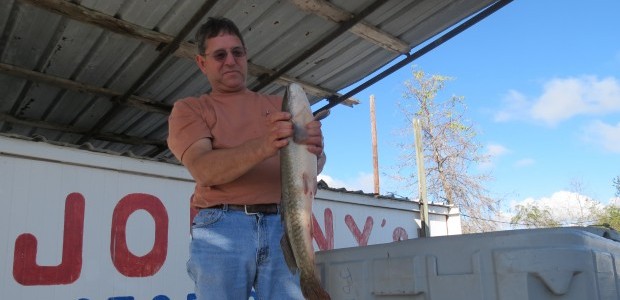Saints earn solid marks in blowout victory
December 19, 2012Chauvin resigns as GIF Inc. CEO
December 19, 2012A popular freshwater fish – known as a non-valuable trash critter to some – has a lot more going for it lately, as the value of its eggs for caviar continues to climb.
State officials say the stocks are healthy and that there is not a need for additional studies. But some processors and dock owners say Louisiana is not paying close enough attention to its stocks of choupique or, as it is otherwise known, bowfin. They are starting a quiet campaign to encourage closer management of the prehistoric-looking fish in hopes of maximizing value and, they say, protecting the species from population problems in the future. A combination of climate issues, egg production by the fish and some other factors are causing local processors and dock owners who rely on fish from the Atchafalaya Basin area to question current practices.
“If you have a thousand fish and they all have eggs and you catch the fish right now, not enough will get to spawn,” said John Ledet of Warbucks Seafood, a Raceland company that is a major exporter of caviar taken from bowfin.
Extremely low water levels in the basin, he and some other processors say, are causing the fish to gang up in holes, making them easy to catch. And that’s a problem, those processors say, because although the season in that region started Dec. 1, the yield of eggs from gravid females has been low. Some docks are reporting a 60 percent drop in egg production.
Ledet and other commercial buyers considered asking the Louisiana Wildlife and Fisheries Commission to shut down this year’s season until January, to give the eggs a chance to get bigger. But the agenda for the December meeting was already sent, and resistance from LDWF staff indicated that the request would likely not go anywhere.
“There is no evidence to suggest need for an emergency closure,” said Mike Wood, the biologist who directs the state’s inland fisheries program. “Harvesters and processors routinely sample bowfin females to determine levels of egg development. Higher development equates to more egg weight and more profit. The low egg yield weights … simply mean that eggs aren’t ripe yet. Nothing more … In fact, LDWF personnel relay observations to me that the situation is quite the contrary. Bowfin are as abundant as ever in the Atchafalaya Basin.”
But current abundance, the dock owners say, does not equate to future abundance. Paddlefish and sturgeon, once seen as healthy in terms of numbers, are now protected. That’s one reason for the importance of bowfin eggs, they maintain, because those from the other species may not be harvested.
Processors and dock owners say they are strictly concerned with stemming the fishing of bowfin by the commercial fishermen who supply them, not recreational fishermen who take after the fish for sport with a rod and reel. While some wildlife officials say the industry should police itself, proponents of a season say some of the counterparts are less concerned about protecting the continued viability of the species than immediate profit. Without restrictions, they argue, the greedier among them can scarf up a lot of fish of questionable value, while decreasing the profit potential for everyone else.
“There should be a season on these fish in the Atchafalaya,” said Linda Blanchard, a dock operator in Loreauville, in St. Martin Parish. “Some of the guys want to start early, they catch the fish. When the fish is ready you get a pound of eggs or more and right now the egg is small, it’s just a tiny little egg.”
In Berwick, dock owner Pat Templet sampled choupique from several fishermen. One brought her 19 female fish that yielded 7 pounds of eggs. She said the yield should have been closer to 20 pounds.
Bayou Sorrel buyer Pete Kelley said this year’s season will see a lot of wasted fish.
“They are fishing too early,” he said. “The eggs are not mature with the a.m. weather. It has a lot to do with the weather. The water is not cold. We caught two choupique and gutted them and they had .64 ounces of eggs. That’s not good at all. Every year, [commercial fishermen] are fishing earlier and earlier. They are killing these choupique and not making any profit. The water is so low and they are going to put the gill nets out. But the eggs are not ready and it’s not feasible. They need a season. Anybody has been in this business knows they are fishing them too early. [The choupique] are going to die in the nets. It should be fished later in the year when the water is good and cold and the fish stays more and more alive.”
Roe must be taken from the choupique while it is still living, processors said, or it is not good to process.
The idea of people who turn a profit in a fishery themselves asking for regulations, to some environmental advocates, is a signal that something needs to be looked at.
Paul Orr of the Louisiana Environmental Action Network, who serves as the official Mississippi River River-keeper under a nationwide program of environmental monitoring, said he is not surprised that state Wildlife and Fisheries staff aren’t necessarily looking outside the box in terms of new regulations, even though the industry is asking for it.
“It is a concern that the state agencies seem to be more governed and act on what politicians say, and the people at the top have a history of not paying attention to the people on the ground as much as they should,” Orr said. “There does not seem to be a lot of motivation from these agencies to do much. They are afraid because (Gov. Bobby) Jindal has this conservative anti-government image and it is impacting the will of the people under him to step in and do what they need to do.”
Orr is not very familiar with the Atchafalaya Basin bowfin issues. But Atchafalaya Basin-keeper Dean Wilson is.
The low water levels, the potential that situation can have on the fish being taken too heavily and too quickly, as well as the issue of eggs developing later than usual, he said, are not news to him.
“The big drought in the Atchafalaya River, it’s a record low flow,” he said. “I think the fishery should be managed by biologists, based on different differences in the years. It has to be based on the realities of what the weather is … Wildlife and Fisheries make a shorter season.”
LDWF’s Mike Wood said criticism of state biologists is not necessarily fair. They have not done direct studies of choupique in the Atchafalaya Basin. But he acknowledged in an interview last week that a closer look at the species and how it is managed could be in order.
“It’s not that we are not interested,” Wood said. “If we had proof that the harvest was going to be a problem. But I am hesitant when the market itself wants a regulation. We do not have a sampling program directed toward bowfin but it is probably warranted that we take a closer look.”
Dock owner Johnny Templet displays a live bowfin, or choupique, taken from waters in the Atchafalaya Basin.











